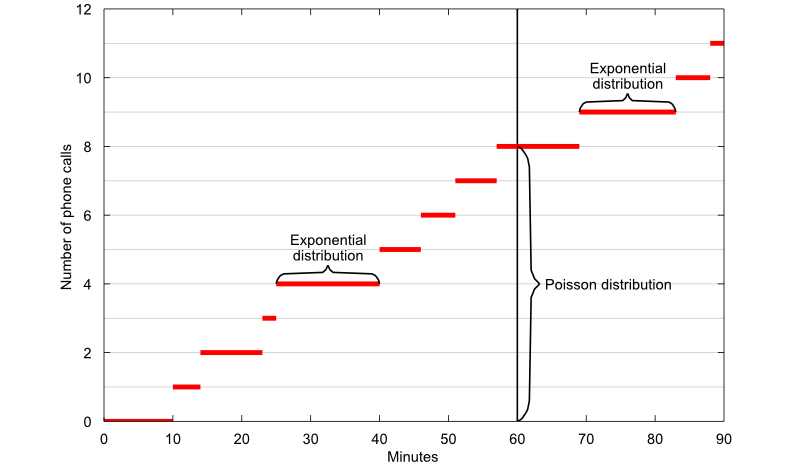Cumulative Distribution Function for Continuous Poisson Distribution Proof
The Poisson distribution is a discrete probability distribution used to model the number of occurrences of a random event.
Table of contents
-
How the distribution is used
-
Example
-
Definition
-
Relation to the exponential distribution
-
Expected value
-
Variance
-
Moment generating function
-
Characteristic function
-
Distribution function
-
Solved exercises
-
Exercise 1
-
Exercise 2
-
Suppose that an event can occur several times within a given unit of time.
When the total number of occurrences of the event is unknown, we can think of it as a random variable.
This random variable has a Poisson distribution if the time elapsed between two successive occurrences of the event:
-
has an exponential distribution;
-
it is independent of previous occurrences.
A classical example of a random variable having a Poisson distribution is the number of phone calls received by a call center.
If the time elapsed between two successive phone calls has an exponential distribution and it is independent of the time of arrival of the previous calls, then the total number of calls received in one hour has a Poisson distribution.

The concept is illustrated by the plot above, where the number of phone calls received is plotted as a function of time:
-
the graph of the function makes an upward jump each time a phone call arrives;
-
the time elapsed between two successive phone calls is equal to the length of each horizontal segment and it has an exponential distribution;
-
the number of calls received in 60 minutes is equal to the length of the segment highlighted by the vertical curly brace and it has a Poisson distribution.
A Poisson random variable is characterized as follows.
The relation between the Poisson distribution and the exponential distribution is summarized by the following proposition.
Proposition The number of occurrences of an event within a unit of time has a Poisson distribution with parameter if the time elapsed between two successive occurrences of the event has an exponential distribution with parameter
and it is independent of previous occurrences.
Proof
The expected value of a Poisson random variable is
Proof
It can be derived as follows: ![[eq18]](https://www.statlect.com/images/Poisson-distribution__46.png)
The variance of a Poisson random variable is
Proof
The moment generating function of a Poisson random variable is defined for any
:
Proof
The characteristic function of a Poisson random variable is
Proof
The distribution function of a Poisson random variable is
where
is the floor of
, i.e. the largest integer not greater than
.
Proof
By using the definition of distribution function, we get ![[eq30]](https://www.statlect.com/images/Poisson-distribution__68.png)
Values of are usually computed by computer algorithms. For example, the MATLAB command:
poisscdf(x,lambda)
returns the value of the distribution function at the point x when the parameter of the distribution is equal to lambda.
Below you can find some exercises with explained solutions.
Exercise 1
The time elapsed between the arrival of a customer at a shop and the arrival of the next customer has an exponential distribution with expected value equal to 15 minutes. Furthermore, it is independent of previous arrivals.
What is the probability that more than 6 customers arrive at the shop during the next hour?
Solution
If a random variable has an exponential distribution with parameter , then its expected value is equal to
. Here
Therefore,
. If inter-arrival times are independent exponential random variables with parameter
, then the number of arrivals during a unit of time has a Poisson distribution with parameter
. Thus, the number of customers that will arrive at the shop during the next hour (denote it by
) is a Poisson random variable with parameter
. The probability that more than 6 customers arrive at the shop during the next hour is
![[eq33]](https://www.statlect.com/images/Poisson-distribution__78.png) and the value of
and the value of can be calculated with a computer algorithm, for example with the MATLAB command
Exercise 2
At a call center, the time elapsed between the arrival of a phone call and the arrival of the next phone call has an exponential distribution with expected value equal to 15 seconds. Furthermore, it is independent of previous arrivals.
What is the probability that less than 50 phone calls arrive during the next 15 minutes?
Solution
Please cite as:
Taboga, Marco (2021). "Poisson distribution", Lectures on probability theory and mathematical statistics. Kindle Direct Publishing. Online appendix. https://www.statlect.com/probability-distributions/Poisson-distribution.
Source: https://www.statlect.com/probability-distributions/Poisson-distribution
0 Response to "Cumulative Distribution Function for Continuous Poisson Distribution Proof"
Post a Comment